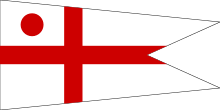Commodore (Royal Navy)
- Please see Commodore (rank) for other versions of this rank.
| Commodore | |
|---|---|
 Flag of a Commodore, Royal Navy. | |
|
The sleeve lace, of a Royal Navy commodore. | |
| Country |
|
| Service branch | |
| Abbreviation | CDRE |
| Rank | one-star |
| NATO rank | OF-6 |
| Non-NATO rank | 6 |
| Next higher rank | Rear Admiral |
| Next lower rank | Captain |
| Equivalent ranks | Brigadier, United Kingdom |
Commodore (Cdre) is a rank of the Royal Navy above captain and below rear admiral. It has a NATO ranking code of OF-6. The rank is equivalent to brigadier in the British Army and Royal Marines and to air commodore in the Royal Air Force.
History
The rank of commodore was introduced during the 17th century in November 1674 (though not legally established until 1806). In 1684 the navy introduced two classes of commodore the first known as a Commodore Distinction and the other a Commodore Ordinary these would later evolve into first and second class commodores.In 1734 the title of commodore was formally approved by an order in council.[1]. They were formally separated into first class (those with subordinate line captains) and second class (those commanding ships themselves) in 1826. The previous broad red and blue pennants were abolished in 1864 along with the coloured squadrons, the commodore of the white's broad pennant with the cross of saint George remained as the command flag for a first class commodore. The white broad pennant with a red ball was introduced as the command flag for the second class commodore. These two flags existed until 1958 when the broad pennant without a ball was abolished leaving the pennant with a single red ball to cover all Royal Navy commodores.
Modern commodores wear the insignia previously worn by commodores second class. Commodore has only been a substantive rank in the Royal Navy since 1997. Before then it continued to be an appointment conferred on senior captains holding certain positions.[2] For example, the senior commander of destroyers within a fleet in the Royal Navy could carry the title of "Commodore (D)", while the fleet's senior commander of submarines could carry the title of "Commodore (S)", although in both cases as an appointment rather than a rank.
Promotion path
From 1570 to 1864 the Royal Navy was divided into colored squadrons which determined an officer's career path.[3]
Rank insignia and personal flag
 Commodores command flag.
Commodores command flag. Commodores sleeve lace.
Commodores sleeve lace.
A modern commodore's rank insignia consists of a 45-millimetre-wide band of gold lace, with a circle of 13-millimetre-wide lace 45 millimetres in diameter above.[4]
Former command flags
Footnotes
- ↑ Perrin, W. G. (William Gordon) (1922). "IV:Flags of Command: Pendants of Command, Commodores". British flags, their early history, and their development at sea; with an account of the origin of the flag as a national device. Cambridge, England: Cambridge : The University Press. p. 102.
- ↑ Debrett's Archived 2012-07-29 at Archive.is
- ↑ Perrin, W. G. (William Gordon) (1922). "IV:Flags of Command". British flags, their early history, and their development at sea; with an account of the origin of the flag as a national device. Cambridge, England: Cambridge : The University Press. pp. 73–109.
- ↑ royalnavy.mod.uk Archived copy at WebCite (February 2, 2011).
Sources
- Perrin, W. G. (William Gordon) (1922). "IV:Flags of Command". British flags, their early history, and their development at sea; with an account of the origin of the flag as a national device. Cambridge, England: Cambridge : The University Press.
See also
References
- "Naval Service Uniform Regulations" (PDF). Fleet Publications and Graphics Organisation. May 2009. Archived from the original (PDF) on 2 February 2011. Retrieved 19 September 2011.
| NATO rank code | Student officer | OF-1 | OF-2 | OF-3 | OF-4 | OF-5 | OF-6 * |
OF-7 ** |
OF-8 *** |
OF-9 **** |
OF-10 ***** | ||
|---|---|---|---|---|---|---|---|---|---|---|---|---|---|
| Royal Navy | O Cdt | Mid | SLt | Lt | Lt Cdr | Cdr | Capt | Cdre | RAdm (list) |
VAdm (list) |
Adm (list) |
Adm of the Fleet | |
| Royal Marines | O Cdt | 2Lt | Lt | Capt | Maj | Lt Col | Col | Brig | Maj-Gen | Lt-Gen | Gen (list) |
Capt-Gen | |
| Army | O Cdt | 2Lt | Lt | Capt | Maj | Lt Col | Col | Brig | Maj-Gen (list) |
Lt-Gen (list) |
Gen (list) |
Fd Mshl | |
| Royal Air Force | Off Cdt / SO | APO / Plt Off | Fg Off | Flt Lt | Sqn Ldr | Wg Cdr | Gp Capt | Air Cdre | AVM | Air Mshl | Air Chf Mshl (list) |
Mshl of the RAF | |